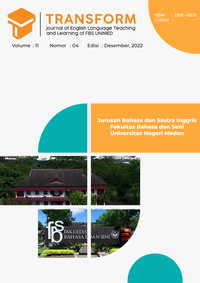THE APPLICATION OF TRANSLATION TECHNIQUES IN TRANSLATING
DOI:
https://doi.org/10.24114/tj.v11i4.46655Keywords:
translation as a profession, translation techniques, translatingAbstract
According to Career Explorer, the translator profession is a job that is responsible for changing the written word from one language to another. This study discusses the translation techniques used for translating. The data of this study is descriptive qualitative based on types and sentences that use translation techniques based on Molina and Albir's theory taken from the translation text. In gathering the data, the researchers use the interview method. Based on the data analysis, use 8 techniques found in the data. The results show (1) borrowing occurs 10 times and represents 1.8%, (2) literal occurs 5 times and represents 3.6%, (3) calque occurs 3 times and represents 6%, (4) equivalent occurs 1 time and represents 18%, (5) Description occurs 1 time and represents 19%, (6) application occurs 2 times and represents 9%, (7) modulation occurs 2 times and represents 9% (8) compensation occurs 1 time and represents 18%.Downloads
Published
2023-06-05
Issue
Section
Articles
License
Copyright (c) 2023 Khairunnisa Br. Batubara, Rizki Ananda Sinurat, Ilyas Fadhil Sebayang, Venia Christina Bukit

This work is licensed under a Creative Commons Attribution-ShareAlike 4.0 International License.
Authors who publish with this journal agree with the following terms:
- Authors retain copyright and grant the journal right of first publication with the work simultaneously licensed under a Creative Commons Attribution License that allows others to share the work with an acknowledgment of the work's authorship and initial publication in this journal.
- Authors are able to enter into separate, additional contractual arrangements for the non-exclusive distribution of the journal's published version of the work (e.g., post it to an institutional repository or publish it in a book), with an acknowledgment of its initial publication in this journal.
- Authors are permitted and encouraged to post their work online (e.g., in institutional repositories or on their website) prior to and during the submission process, as it can lead to productive exchanges, as well as earlier and greater citation of published work (See The Effect of Open Access).
- This work is licensed under a Creative Commons Attribution-ShareAlike 4.0 International License.

This work is licensed under a Creative Commons Attribution-NonCommercial-ShareAlike 4.0 International License.



